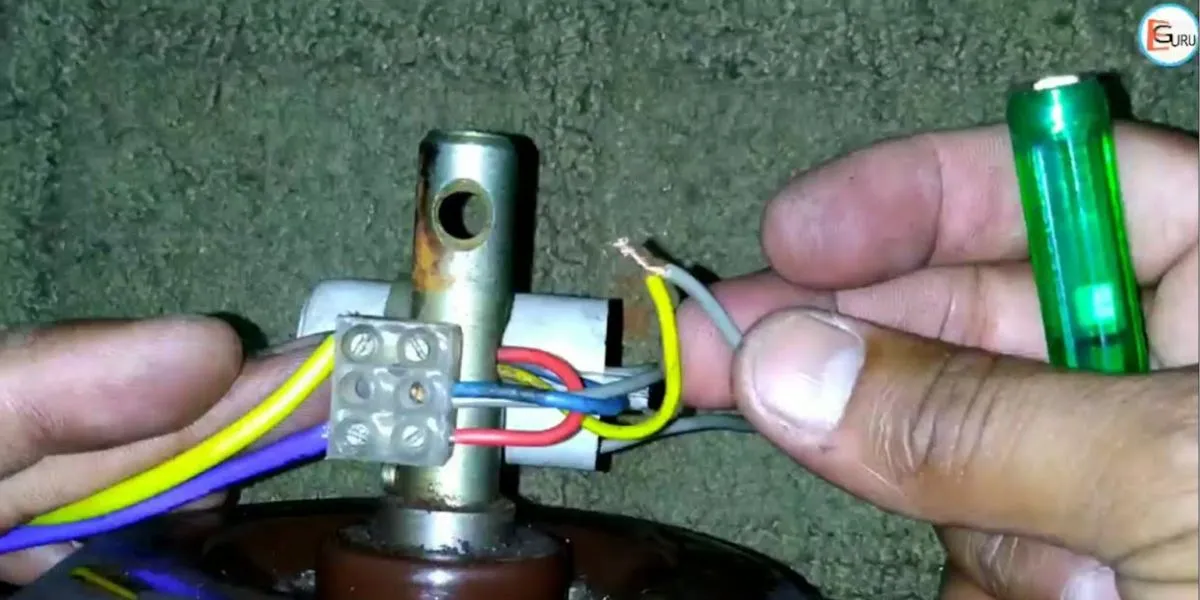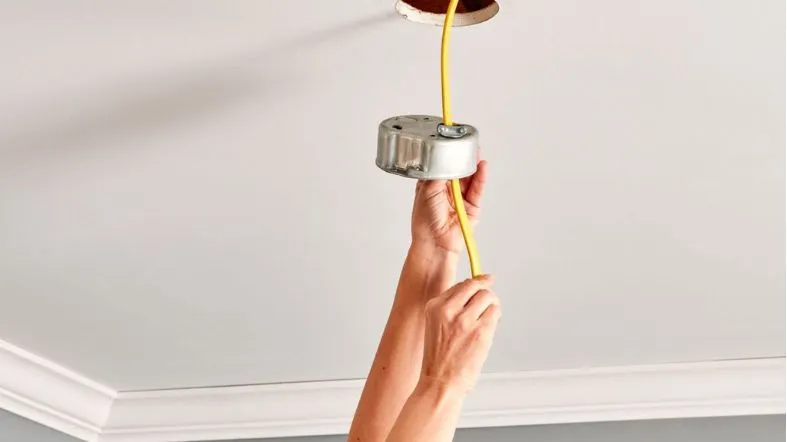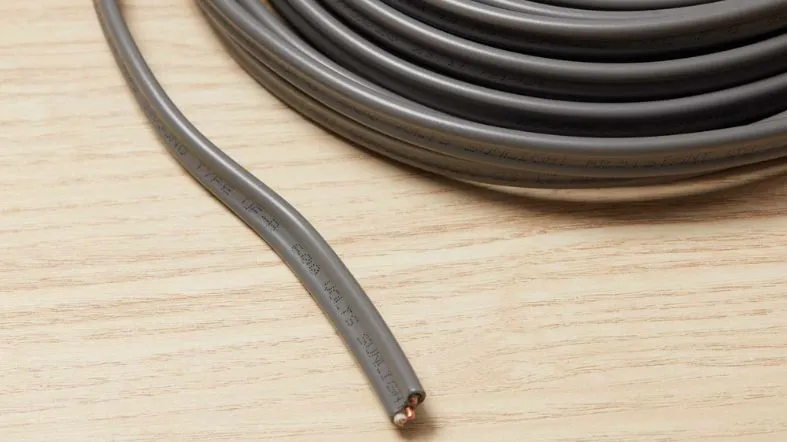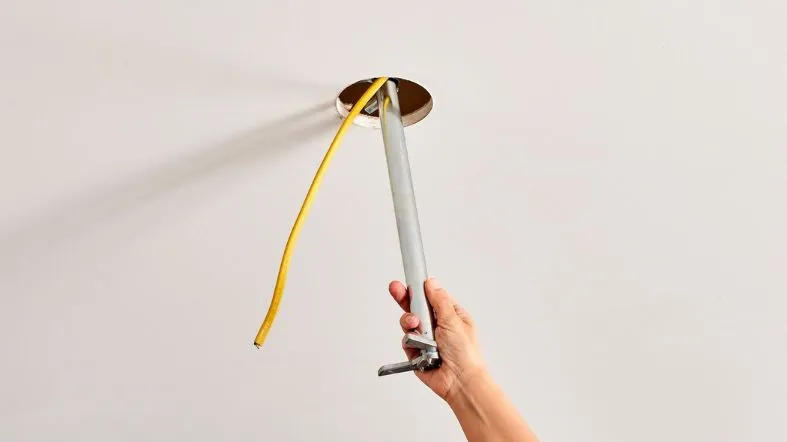If you are planning to install a ceiling fan in your home, you might be wondering what size wire you need to use.
Choosing the right wire size is important for the safety and performance of your ceiling fan, as well as for complying with the electrical codes and regulations in your area.
In this blog post, we will explain the factors that influence the wire size selection for ceiling fans, and provide a step-by-step guide to help you make the best decision.

What Size Wire for Ceiling Fan?
For installing a ceiling fan, a 14-gauge wire is suitable for circuits carrying 15 amps or less, while a 12-gauge wire is ideal for circuits carrying 20 amps. Consulting the fan manual and local building codes is essential to ensure compliance and safety in wiring installations.
Ceiling Fan Wire Size Chart:
| Wire Gauge | Suitable Amperage | Appropriate For |
|---|---|---|
| 14-gauge | 15 amps | Standard residential ceiling fans |
| 12-gauge | 20 amps | Larger, industrial ceiling fans |
Types of Wires Used in Ceiling Fan Installation
There are different types of wires that can be used for ceiling fan installation, depending on the material, gauge, and configuration. Here are some of the common ones:
Copper Wires
Copper wires are the most popular and widely used wires for ceiling fans, as they are durable, flexible, and have good conductivity.
Copper wires are also resistant to corrosion and oxidation, which makes them suitable for damp or humid environments.
However, copper wires are also more expensive and heavier than other types of wires.
Aluminum Wires
Aluminum wires are cheaper and lighter than copper wires, but they have lower conductivity and higher resistance.
Aluminum wires are also more prone to corrosion and oxidation, which can cause overheating and fire hazards.
Therefore, aluminum wires are not recommended for ceiling fan installation, unless they are specially designed and approved for this purpose.
Copper-Clad Aluminum Wires
Copper-clad aluminum wires are a hybrid of copper and aluminum wires, where a thin layer of copper is coated over an aluminum core.
This gives them the advantages of both materials, such as lower cost, lighter weight, and good conductivity.
However, copper-clad aluminum wires also have some drawbacks, such as difficulty in splicing and terminating, and potential compatibility issues with some devices and connectors.
Stranded Wires
Stranded wires are composed of several thin strands of wire twisted together to form a single conductor.
Stranded wires are more flexible and durable than solid wires, as they can withstand bending and vibration better. Stranded wires are also easier to install in tight spaces and corners.
However, stranded wires also have higher resistance and lower conductivity than solid wires, which means they require larger gauges to carry the same amount of current.
Factors Influencing Wire Size Selection for Ceiling Fans

The wire size for a ceiling fan is determined by several factors, such as:
1. Ceiling Fan Model and Power Requirement
The first factor to consider is the ceiling fan model and its power requirement.
Different ceiling fans have different sizes, speeds, features, and wattages, which affect how much current they draw from the electrical circuit.
The wire size must be able to handle the maximum current that the ceiling fan can draw without overheating or causing a voltage drop.
To find out the power requirement of your ceiling fan, you can check the label on the fan motor or consult the manufacturer’s specifications.
The power requirement is usually expressed in watts or amperes (amps). You can use this formula to convert between them:
Watts = Volts x Amps
For example, if your ceiling fan has a power requirement of 60 watts at 120 volts, then it draws 0.5 amps from the circuit.
60 watts = 120 volts x 0.5 amps
The table below shows some common wire sizes and their maximum current ratings at 120 volts:
| Wire Size (AWG) | Maximum Current (Amps) |
|---|---|
| 14 | 15 |
| 12 | 20 |
| 10 | 30 |
| 8 | 40 |
| 6 | 55 |
As a general rule of thumb, you should choose a wire size that has at least 25% more capacity than the current drawn by your ceiling fan.
This will provide some safety margin and prevent overheating or voltage drop.
For example, if your ceiling fan draws 0.5 amps from the circuit, then you should use a wire size that can handle at least 0.625 amps (0.5 x 1.25).
According to the table above, a 14 AWG wire would be sufficient for this purpose.
However, this is only a rough estimate based on ideal conditions. There are other factors that may affect the actual current rating of a wire size, such as the length of the wire run, the ambient temperature, and the number of conductors in a cable.
Therefore, you should always consult an electrician or follow the manufacturer’s recommendations before choosing a wire size for your ceiling fan.
2. Length of Wire Run

The second factor to consider is the length of the wire run between the power source and the ceiling fan.
The longer the wire run is, the more resistance it will have, which will cause a voltage drop along the way.
A voltage drop means that less voltage will reach the ceiling fan motor, which may affect its performance and lifespan.
To avoid a significant voltage drop, you should limit the length of the wire run to a certain maximum, depending on the wire size and the current drawn by the ceiling fan.
The table below shows some examples of maximum wire run lengths for different wire sizes and currents at 120 volts:
| Wire Size (AWG) | Current (Amps) | Maximum Wire Run Length (Feet) |
|---|---|---|
| 14 | 0.5 | 240 |
| 14 | 1 | 120 |
| 14 | 2 | 60 |
| 12 | 0.5 | 384 |
| 12 | 1 | 192 |
| 12 | 2 | 96 |
| 10 | 0.5 | 614 |
| 10 | 1 | 307 |
| 10 | 2 | 153 |
As you can see, the maximum wire run length decreases as the current increases and as the wire size decreases.
Therefore, if you have a long wire run or a high current ceiling fan, you may need to use a larger wire size to avoid a voltage drop.
3. Electrical Codes and Regulations
The third factor to consider is the electrical codes and regulations in your area. Different jurisdictions may have different requirements and standards for ceiling fan installation, wiring, and safety.
You should always follow the local codes and regulations when choosing a wire size for your ceiling fan, as they are designed to protect you and your property from electrical hazards.
Some of the common electrical codes and regulations that may affect your wire size selection are:
National Electrical Code (NEC)
The NEC is a widely adopted code that sets the minimum standards for safe electrical installation and wiring in the United States.
The NEC covers topics such as wire size, wire material, wire insulation, wire color, wire splicing, wire connectors, wire grounding, wire protection, circuit breakers, switches, outlets, fixtures, and more.
You can find the latest edition of the NEC online or at your local library.
Local Building Codes
Local building codes are codes that are adopted by your city, county, or state to regulate the construction and renovation of buildings and structures in your area.
Local building codes may have additional or different requirements than the NEC for ceiling fan installation and wiring, such as permits, inspections, clearances, supports, boxes, fans, lights, and more.
You can find out more about your local building codes by contacting your local building department or authority.
Manufacturer’s Instructions
Manufacturer’s instructions are instructions that are provided by the ceiling fan manufacturer or supplier to guide you on how to install and operate your ceiling fan safely and correctly.
Manufacturer’s instructions may have specific recommendations or requirements for the wire size, wire material, wire connection, fan mounting, fan operation, fan maintenance, and more.
You should always read and follow the manufacturer’s instructions before choosing a wire size for your ceiling fan.
4. Home Wiring System
The fourth factor to consider is the home wiring system that you have in your house.
The home wiring system is the network of wires, cables, conduits, panels, boxes, outlets, switches, fixtures, appliances, and devices that deliver electricity from the utility service to your home and distribute it throughout your rooms and spaces.
The home wiring system may affect your wire size selection in several ways:
5.Voltage
The voltage is the measure of electrical potential difference between two points in a circuit.
The voltage determines how much force is applied to push the current through the circuit.
The standard voltage for residential wiring in North America is 120 volts for most circuits and 240 volts for some heavy-duty circuits.
The voltage affects the wire size selection because higher voltage means lower current for the same power requirement.
Therefore, you may be able to use a smaller wire size for a higher voltage circuit than for a lower voltage circuit.
Amperage – The amperage is the measure of electrical current flowing through a circuit.
The amperage determines how much heat is generated by the resistance of the circuit.
The standard amperage for residential wiring in North America is either 15 amps or 20 amps for most circuits.
The amperage affects the wire size selection because higher amperage means higher current for the same power requirement.
Therefore, you may need to use a larger wire size for a higher amperage circuit than for a lower amperage circuit.
Circuit Breaker – The circuit breaker is a device that protects the circuit from overloading or short-circuiting by interrupting the flow of current when it exceeds a certain limit.
The circuit breaker also serves as a switch to turn on or off the power to the circuit. The standard circuit breaker sizes for residential wiring in North America are either 15 amps or 20 amps for most circuits.
The circuit breaker affects the wire size selection because it limits the maximum current that the wire can safely carry without tripping.
Therefore, you should match the wire size with the circuit breaker size to avoid overloading or underloading the circuit.
For example, if your ceiling fan draws 0.5 amps from the circuit, and you have a 15-amp circuit breaker, then you should use a 14 AWG wire, which can handle up to 15 amps.
However, if you have a 20-amp circuit breaker, then you should use a 12 AWG wire, which can handle up to 20 amps.
6. Environmental Conditions

The fifth factor to consider is the environmental conditions where the ceiling fan is installed.
The environmental conditions may affect the wire size selection in terms of temperature, moisture, and exposure.
- Temperature – The temperature is the measure of how hot or cold something is. The temperature affects the wire size selection because higher temperature means lower resistance and higher current for the same voltage. Therefore, you may need to use a larger wire size for a higher temperature environment than for a lower temperature environment.
- Moisture – The moisture is the measure of how wet or dry something is. The moisture affects the wire size selection because higher moisture means higher conductivity and lower resistance for the same voltage. Therefore, you may need to use a larger wire size for a higher moisture environment than for a lower moisture environment.
- Exposure – The exposure is the measure of how much something is in contact with air, water, sunlight, chemicals, or other elements. The exposure affects the wire size selection because higher exposure means higher risk of corrosion, oxidation, deterioration, or damage for the same voltage. Therefore, you may need to use a larger wire size for a higher exposure environment than for a lower exposure environment.
To account for these environmental factors, you should use a wire size that has an appropriate insulation rating and protection level for your ceiling fan location.
The insulation rating is a code that indicates the maximum temperature that the wire can withstand without losing its integrity or performance.
The protection level is a code that indicates the degree of protection that the wire has against moisture, dust, dirt, oil, gas, or other contaminants.
The table below shows some common insulation ratings and protection levels for wires:
| Insulation Rating | Maximum Temperature (°C) | Protection Level | Description |
|---|---|---|---|
| TW | 60 | None | Thermoplastic wet location; suitable for indoor use in damp locations |
| THW | 75 | None | Thermoplastic heat and wet location; suitable for indoor or outdoor use in wet locations |
| THWN | 90 | Nylon | Thermoplastic heat and wet location with nylon coating; suitable for indoor or outdoor use in wet locations with extra protection against abrasion and chemicals |
| THHN | 90 | Nylon | Thermoplastic high heat with nylon coating; suitable for indoor use in dry locations with high temperatures and extra protection against abrasion and chemicals |
| XHHW | 90 | Cross-linked | Cross-linked polyethylene heat and wet location; suitable for indoor or outdoor use in wet locations with high temperatures and extra protection against abrasion and chemicals |
As a general rule of thumb, you should choose a wire size that has an insulation rating and protection level that are equal to or higher than the environmental conditions where your ceiling fan is installed.
For example, if your ceiling fan is installed in an outdoor patio that is exposed to rain, sun, and heat, then you should use a wire size that has at least a THWN or XHHW insulation rating and protection level.
7. Budget Considerations
The sixth factor to consider is your budget considerations. The budget considerations may affect your wire size selection in terms of cost, availability, and quality.
- Cost – The cost is the amount of money that you need to spend to buy or install the wire. The cost affects the wire size selection because larger wire sizes are usually more expensive than smaller wire sizes. Therefore, you may want to use a smaller wire size if you have a limited budget or want to save money.
- Availability – The availability is the degree of ease or difficulty that you have to find or obtain the wire. The availability affects the wire size selection because some wire sizes may be more common or readily available than others. Therefore, you may want to use a more common or readily available wire size if you have a tight schedule or want to avoid delays.
- Quality – The quality is the measure of how good or bad something is in terms of performance, durability, reliability, or safety. The quality affects the wire size selection because some wire sizes may have better quality than others. Therefore, you may want to use a better quality wire size if you have high standards or want to avoid problems.
As a general rule of thumb, you should choose a wire size that balances your budget considerations with your other factors such as power requirement, wire run length, electrical codes, home wiring system, and environmental conditions.
For example, if your ceiling fan has a low power requirement, a short wire run length, and a simple home wiring system, then you may be able to use a smaller and cheaper wire size.
However, if your ceiling fan has a high power requirement, a long wire run length, or a complex home wiring system, then you may need to use a larger and more expensive wire size.
Step-by-Step Guide to Choosing the Right Wire Size

Now that you know the factors that influence the wire size selection for ceiling fans, you can follow this step-by-step guide to help you choose the right wire size for your ceiling fan:
Step 1: Identify the Ceiling Fan’s Power Requirements
The first step is to identify the ceiling fan’s power requirements. You can do this by checking the label on the fan motor or consulting the manufacturer’s specifications.
You should find out the voltage, amperage, and wattage of your ceiling fan.
Step 2: Measure the Distance Between Power Source and Fan
The second step is to measure the distance between the power source and the ceiling fan.
You can do this by using a tape measure or a laser distance meter. You should measure the length of the wire run from the circuit breaker panel to the switch box, and from the switch box to the ceiling fan box.
Step 3: Check Local Codes and Regulations
The third step is to check the local codes and regulations in your area. You can do this by contacting your local building department or authority, or by consulting an electrician or a licensed contractor.
You should find out the minimum wire size, wire material, wire insulation, wire color, wire splicing, wire connectors, wire grounding, wire protection, circuit breaker size, switch type, outlet type, fixture type, and other requirements for ceiling fan installation and wiring in your area.
Step 4: Factor in the Home’s Electrical System
The fourth step is to factor in the home’s electrical system that you have in your house. You can do this by inspecting your circuit breaker panel, switch box, outlet box, ceiling fan box, and other components of your home wiring system.
You should find out the voltage, amperage, circuit breaker size, switch type, outlet type, fixture type, and other characteristics of your home wiring system.
Step 5: Choose the Right Wire Material
The fifth step is to choose the right wire material for your ceiling fan. You can do this by comparing the pros and cons of different types of wires such as copper wires, aluminum wires, copper-clad aluminum wires, and stranded wires.
You should choose a wire material that has good conductivity, durability, flexibility, compatibility, and affordability for your ceiling fan.
Step 6: Make the Final Decision
The sixth and final step is to make the final decision on the wire size for your ceiling fan.
You can do this by using a wire size calculator or a wire size chart that takes into account all the factors that we have discussed above.
You should choose a wire size that matches or exceeds your ceiling fan’s power requirements, your wire run length, your local codes and regulations, your home wiring system, and your environmental conditions.
FAQs
Can I use aluminum wires for ceiling fan installation?
Using aluminum wires for ceiling fan installation is generally not recommended due to their lower conductivity and higher resistance compared to copper wires.
Copper wires are a safer and more reliable choice for this purpose.
Is it necessary to consider local electrical codes for wire size selection?
Yes, it’s essential to consider local electrical codes and regulations when choosing a wire size for your ceiling fan to ensure compliance with safety standards and prevent electrical hazards.
Are stranded wires better than solid wires for ceiling fan installation?
Stranded wires are often preferred for ceiling fan installation due to their flexibility, durability, and ability to handle bending and vibration better than solid wires.
Do I need to factor in the environmental conditions for wire size selection?
Yes, environmental conditions such as temperature, moisture, and exposure should be considered when selecting the right wire size for your ceiling fan to ensure safety and longevity.
Does the length of the wire run affect wire size selection?
Yes, the length of the wire run between the power source and the ceiling fan impacts wire size selection.
Longer wire runs can lead to voltage drop, which should be minimized by using an appropriate wire size.
Can I choose a wire size solely based on my ceiling fan’s power requirement?
While considering the ceiling fan’s power requirement is important, other factors such as wire run length, electrical codes, home wiring system, and environmental conditions should also be taken into account for accurate wire size selection.
Is it necessary to use wires with higher capacity than my ceiling fan’s current draw?
Yes, it’s recommended to choose a wire size that has at least 25% more capacity than the current drawn by your ceiling fan.
This helps prevent overheating and voltage drop, ensuring safe and efficient operation.
Conclusion
Choosing the right wire size for a ceiling fan is not as simple as it may seem.
There are many factors that influence the wire size selection for ceiling fans, such as power requirement, wire run length, electrical codes, home wiring system, environmental conditions, and budget considerations.
By following our step-by-step guide and using our tips and tricks, you should be able to choose the right wire size for your ceiling fan with ease and confidence.

